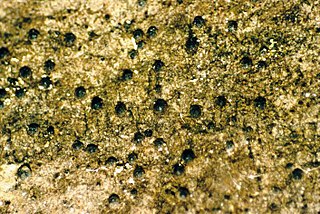
The Physciaceae are a family of mostly lichen-forming fungi belonging to the class Lecanoromycetes in the division Ascomycota. A 2016 estimate placed 19 genera and 601 species in the family.

Lopadium is a genus of lichen-forming fungi in the monotypic family Lopadiaceae, which is in the order Lecideales. The genus contains 10 species. Lopadium was circumscribed by German lichenologist Gustav Wilhelm Körber in 1855.

Anaptychia is a genus of lichenized fungi in the family Physciaceae.

Physconia is a genus of lichen-forming fungi in the family Physciaceae. It has about 25 species. The genus was circumscribed by Czech lichenologist Josef Poelt in 1965, with Physconia pulverulenta assigned as the type species.
Ioplaca is a genus of crustose lichens in the family Teloschistaceae. The genus was circumscribed in 1977 by Czech lichenologist Josef Poelt with Ioplaca sphalera assigned as the type species.

Bagliettoa is a genus of lichen-forming fungi in the family Verrucariaceae. The genus was circumscribed by Italian lichenologist Abramo Bartolommeo Massalongo in 1853. Bagliettoa species are endolithic, growing between the grains of solid rock.

Pleurosticta is a genus of lichen belonging to the family Parmeliaceae. It has two species. The genus was circumscribed by mycologist Franz Petrak in 1931, with Pleurosticta lichenicola assigned as the type species. This is now known as a synonym of P. acetabulum.
Bryonora is a genus of crustose lichens in the family Lecanoraceae. The genus was circumscribed in 1983 by lichenologist Josef Poelt, with Bryonora castanea assigned as the type species.
Sagema is a fungal genus in the family Lecanoraceae. It is a monotypic genus, containing a single species, the crustose lichen Sagema potentillae, found in Nepal. Both the genus and species were described in 1993 by lichenologists Josef Poelt and Martin Grube.

The Candelariales are an order of fungi in the monotypic class Candelariomycetes. It contains the families Candelariaceae and Pycnoraceae. The order was circumscribed by Jolanta Miadlikowska, François Lutzoni, and Helge Thorsten Lumbsch as part of a comprehensive phylogenetic classification of the kingdom Fungi published in 2007. The class Candelariomycetes was created in 2018 by Hermann Voglmayr and Walter Jaklitsch.

Candelariaceae is a family of lichen-forming fungi in the order Candelariales. It contains seven genera and about 73 species. The family was circumscribed by Finnish lichenologist Rainar Hakulinen in 1954 to contain the type genus, Candelaria.

Placomaronea is a genus of lichenized fungi in the family Candelariaceae. It has 6 species. The genus was circumscribed by Finnish lichenologist Veli Räsänen in 1944, with Placomaronea candelarioides assigned as the type species. The genus was revised by Martin Westberg and colleagues in 2009, who accepted six species in the genus.
Lithogyalideopsis is a genus of lichen-forming fungi in the family Gomphillaceae.

Protoblastenia is a genus of lichens in the family Psoraceae. It was originally circumscribed by Alexander Zahlbruckner in 1908 as a section of genus Blastenia. J. Steiner promoted it to generic status in 1911.

Ropalospora is a genus of lichen-forming fungi, and the sole member of the monogeneric family Ropalosporaceae. The genus was circumscribed by Italian lichenologist Abramo Bartolommeo Massalongo in 1860. The family was proposed by Josef Hafellner in 1984.
Vezdaea is a genus of crustose lichens in the monotypic family Vezdaeaceae, which itself is the only taxon in the order Vezdaeales. The genus was circumscribed by Elisabeth Tschermak-Woess and Josef Poelt in 1976. The genus name honours Czech lichenologist Antonín Vězda.

Arthrorhaphis is a genus of lichen-forming fungi in the monotypic family Arthrorhaphidaceae. It has 13 species. The genus was circumscribed by Theodor Magnus Fries in 1860. The family was proposed by lichenologists Josef Poelt and Josef Hafellner in 1976. Species in this family have a widespread distribution in temperate and montane habitats. They grow symbiotically with green algae, or parasitically on other lichens. The family Arthrorhaphidaceae has an uncertain taxonomic placement in the class Lecanoromycetes; that is, it is incertae sedis with respect to ordinal placement.

Scoliciosporum is a genus of lichens in the family Scoliciosporaceae.
Apatoplaca is a fungal genus in the family Teloschistaceae. It is monotypic, containing a single species, the rare crustose lichen Apatoplaca oblongula, found in the United States.
Sphaeropezia is a genus of fungi in the family Odontotremataceae. It has 22 species. Originally circumscribed by Pier Andrea Saccardo in 1884, the genus was resurrected and revised in 2013.













